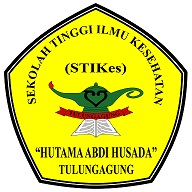Identification of negative Gram bacteria in diabetes mellitus gangrene at RSUD dr. Soedomo Trenggalek
DOI:
https://doi.org/10.35584/melysa.v1i2.34Keywords:
Diabetes Mellitus, gram negative, gangrene, bacteriaAbstract
Diabetes mellitus is a metabolic disease due to an increase in blood glucose levels normal. Gangrene diabetes is tissue death due to obstruction of blood vessels that provides nutrients to obstructed tissue and is a form of complications from diabetes mellitus. Pseudomonas aeruginosa is one of the causes of gangrene infection nosocomial opportunistic infections in humans. The purpose of this study was to determine the presence of gram-negative bacteria in the wounds of Gangrene Diabetes Mellitus. This research is a descriptive Non-Analytic, conducted on April 15 to May 21, 2019, in the Microbiology Laboratory of STIKes Hutama Abdi Husada Tulungagung. The study sample was all patients with Gangrene Diabetes Mellitus wound in hospital dr. Soedomo Trenggalek, the sampling technique used was accidental sampling, obtained a sample of 4 Gangrene swabs. The study was conducted by the identification of gram-negative bacterial isolation. The results of the study were 4 samples, 2 were positive for Pseudomonas aeruginosa and 2 samples were positive for Proteus sp. Subsequent research results were analyzed descriptively. The conclusion of this research is that 100% positive gram-negative. The typical characteristics of the Pseudomonas aeruginosa bacteria are obtained on the MCH media (alkaline slope, alkaline base, negative gas, negative H2S) and on the NAS produce greenish-yellow fluorescence, while the typical characteristics of Proteus sp are obtained on the MCH media (alkaline slope, alkaline slope, base negative) acid, positive gas, positive H2S).
Downloads
References
Akram T Kharroubi, Hisham M Darwish. Diabetes mellitus: The epidemic of the century. World J Diabetes. 2015; 25; 6(6): 850-867. doi:10.4239/wjd.v6.i6.850
Yohanna Eclesia Lumban Gaol, Erly, Elmatris Sy. Pola Resistensi Bakteri Aerob pada ulkus diabetic terhadap beberapa antibiotic di Laboratorium Mikrobiologi RSUP Dr. M. Djamil Padang Tahun 2011-2013. J Kesehatan Andalas. 2017;6(1):164. doi:10.25077/jka.v6i1.664
Nur A, Marissa N. Gambaran Bakteri Ulkus Diabetikum di Rumah Sakit Zainal Abidin dan Meuraxa Tahun 2015. Buletin Penelitian Kesehatan. 2016; 44 (3):187 – 196. doi:10.22435/bpk.v44i3.5048.187-196
Kementerian Kesehatan RI. Profil Kesehatan Indonesia. Jakarta: Depkes RI; 2014
Isnaini N, Ratnasari R. Faktor risiko mempengaruhi kejadian Diabetes mellitus tipe dua. J Kebidanan dan Keperawatan Aisyiyah. 2018;14(1):59-68. doi:10.31101/jkk.550.
Wijoseno G. Jantung, pembuluh darah arteri, vena dan limfe. Dalam: de Jong W, editor. Buku ajar ilmu bedah. Edisi ke-4. Jakarta: EGC; 2017
Richard, J. L., Sotto, A. & Lavigne, J., New insights in diabetic foot infection. World J Diabetes. 2011;2(2):24-32. doi:10.4239/wjd.v2.i2.24
Benwan Khalifa Al, Mulla Ahmed Al, Rotimi Vincent O. A study of the microbiology of diabetic foot infections in a teaching hospital in Kuwait. Journal of Infection and Public Health. 2012; 5(1):1-8. doi:10.1016/j.jiph.2011.07.004
Vivanco, A.L., Espinoza, F.M., Mayorga, F.C., Luna, J.S., Tandazo, M.C., Rueda, E.Y.R. and Davila, K.D. Bacteriological Profile in Diabetic Foot Patients. Journal of Diabetes Mellitus. 2017; 7:265-274. doi:10.4236/jdm.2017.74021
Banu A, Noorul Hassan MM, Rajkumar J, Srinivasa S. Spectrum of bacteria associated with diabetic foot ulcer and biofilm formation: A prospective study. AMJ. 2015;8(9): 280-285. doi:10.4066/AMJ.2015.2422
Nese Saltoglu, Onder Ergonul, Necla Tulek. Influence of multidrug resistant organisms on the outcome of diabetic foot infection. International Journal of Infectious Diseases.2018;70:10-14. doi:10.1016/j.ijid.2018.02.013
Powlson Andrew S Anthon, y P. Coll. The treatment of diabetic foot infections. J Antimicrob Chemothe. 2010; 65(3):3–9. doi:10.1093/jac/dkq299
Uckay Ilker, Javier Arago´n-Sa´nchez , Daniel Lew, Benjamin A. Lipsky. Diabetic foot infections: what have we learned in the last 30 years? International Journal of Infectious Diseases.2015;40: 81-91. doi:10.1016/j.ijid.2015.09.023
Heravi FS, Zakrzewski M, Vickery K, Armstrong DG, Hu H. Bacterial Diversity of Diabetic Foot Ulcers: Current Status and Future Prospectives. Journal of Clinical Medicine. 2019; 8. doi:10.3390/jcm8111935
Eleonora Aquilini, Joana Azevedo, Natalia Jimenez, Lamiaa Bouamama, Juan M. Toma´s, and Miguel Regue. Functional Identification of the Proteus mirabilis Core Lipopolysaccharide Biosynthesis Genes. Journal of Bacteriology. 2010;192(17): 4413–4424. doi:10.1128/JB.00494-10
Banaz M. Latif, Salah. S. Zayn Aleabdyn and Ibraheem S. Ahmed. A Comparative Bacteriological and Molecular Study on Some Virulence Factor of Proteus spp Isolated from Clinical and Environment Specimens. Int.J.Curr.Res.Aca.Rev. 2017; 5(5): 26-33. doi:10.20546/ijcrar.2017.505.005
Janak, Kishore. Isolation, Identification & Characterization of Proteus penneri - a missed rare pathogen. Indian J Med Res. 2012; 135(3): 341–345.
Amrullah Shidiki, Bijay Raj Pandit and Ashish Vyas. Characterization and Antibiotic profile of Pseudomonas aeruginosa isolated from patients visiting National Medical college and Teaching Hospital, Nepal. Acta Scientific Pharmaceutical Sciences. 2019;3(7): 02-06. doi:10.31080/ASPS.2019.03.0296
Jawetz, Melnick. et.al. Mikrobiologi Kedokteran, Alih Bahasa Aryandhito Widhi Nugroho et.al., editor edisi Bahasa Indonesia Adisti Adityaputri Edisi 25, Jakarta: EGC; 2012
Harti, a.s. Mikrobiologi Kesehatan: Peran Mikrobiologi Dalam Bidang Kesehatan. Yogyakarta: Andi Offset; 2015
Carrol, K, C., Stephen A Morse., Timothy Mietzner., Steve Miller. Jawetz, Melnick. & Adelberg. Mikrobiologi Kedokteran (ed 27). Jakarta: ECG; 2017
Trojan R, Razdan L, Singh N. Antibiotic Susceptibility Patterns of Bacterial Isolates from Pus Samples in a Tertiary Care Hospital of Punjab, India. International Journal of Microbiology. 2016;2016:2-4. doi:10.1155/2016/9302692
Giurato L, Meloni M, Izzo V, Uccioli L. Osteomyelitis in diabetic foot: A comprehensive overview. World J Diabetes. 2017;8(4): 135-142. doi: 10.4239/wjd.v8.i4.135
Downloads
Additional Files
Published
Issue
Section
License
Authors retain copyright and grant the journal right of first publication with the work simultaneously licensed under a Creative Commons Attribution-ShareAlike 4.0 International License that allows others to share the work with an acknowledgment of the work's authorship and initial publication in this journal.














